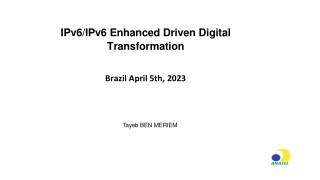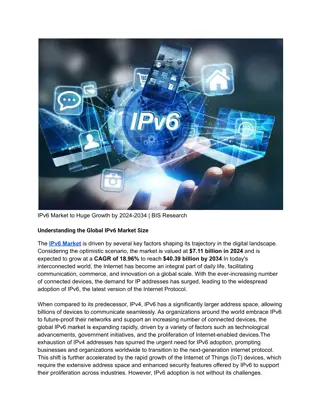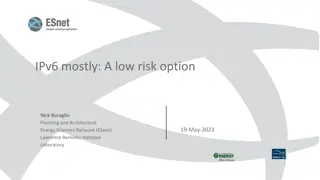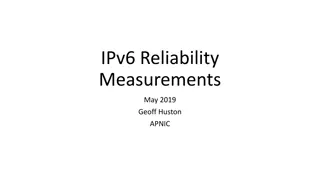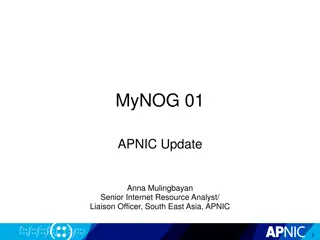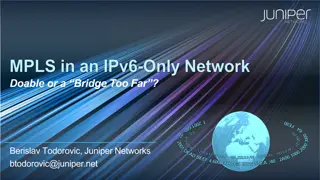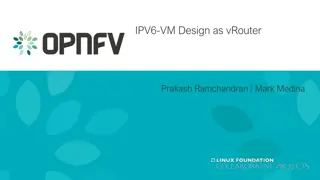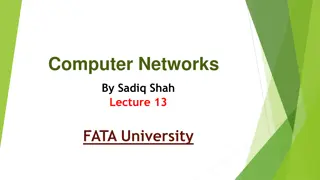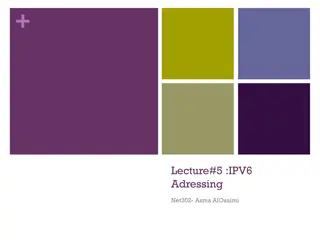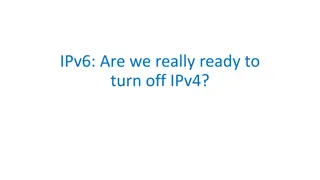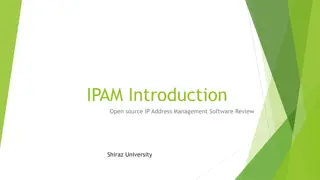IPv6 Public Policy Considerations - Addressing the Global IP Address Shortage
In light of the global shortage of IPv4 addresses, there is a pressing need for a fair policy for the allocation of remaining addresses. The rapid growth of the Internet has further increased demand for IP addresses, with IPv4 expected to run out soon. The deployment of IPv6 has become a critical issue in the transition from IPv4 to IPv6, emphasizing the importance of a smooth migration. Management of IPv4 addresses, distribution, and the status of 256/8s IPV4 address space are important considerations in the context of public policy.
Download Presentation

Please find below an Image/Link to download the presentation.
The content on the website is provided AS IS for your information and personal use only. It may not be sold, licensed, or shared on other websites without obtaining consent from the author.If you encounter any issues during the download, it is possible that the publisher has removed the file from their server.
You are allowed to download the files provided on this website for personal or commercial use, subject to the condition that they are used lawfully. All files are the property of their respective owners.
The content on the website is provided AS IS for your information and personal use only. It may not be sold, licensed, or shared on other websites without obtaining consent from the author.
E N D
Presentation Transcript
IPv6 Public Policy Considerations Houlin Zhao Deputy Secretary-General International Telecommunication Union
I. Introduction Global Shortage of IP addresses Continued rapid growth of the Internet, IP addresses have greater demand Despite NAT, IPv4 addresses expected to run out in the next few years Need a fair and equitable policy for allocation of the remaining IPv4 address space Now, deployment of IPv6 has become an urgent global issue Public policy concern on IPv6 is The smooth migration from IPv4 to IPv6
II. Internet Addressing IP Addresses connect the Internet Number / Address 5 RIRs Internet Protocol LIR / ISPs Number / Address End Users
Current IP address version: IPv4 Fixed length, 32 bit scheme, more than 4 billion (232) addresses Management of IPv4 address space by IANA (ICANN), RIRs Low Government involvement; need for International cooperation Policy to assign IPv4 addresses was based on First come, First serve Preoccupancy of substantial amount of IPv4 addresses stockpiled by early entrants and will likely not be available to those who need it Distribution of IPv4 : Serious lack of global balance (leans towards ARIN> APNIC > RIPE NCC)
Status of 256 / 8s IPv4 Address Space Private Use 1 Loopback 1 TOTAL IPv4 SPACE Local Identification 1 Multicast 16 Central Registry : 91 Not Available : 35 IANA Reserve : 34 Experimental 16 RIRs : 96 AfrNIC 3 LACNIC 6 ARIN 31 > APNIC 30 > RIPE NCC 26 > LACNIC 6> AfrNIC3 (out of RIRs 96) ARIN 31 RIPE NCC 26 APNIC 30 Source: Internet Number Resource Status Report (Number Resource Organization, As of 31 Dec. 2008),
6 5 4 3 2 1 IPv4 Address Space Issued : RIRs to Customers (Jan. 1999 Dec. 2008) 0 IPv4 Address Space Issued by year Source: INR Status Report (NRO, As of 31 Dec. 2008)
Each RIR will be allocated one /8 IPv4 address block when the IANA free pool of IPv4 address space reaches five remaining /8 blocks Proposed by the Address Supporting Organization Address Council (ASO AC) for ratification by the ICANN Board All RIRs have formally adopted the proposal (Nov. 2008) Public comments would be open until 26 Feb. 2009 http://www.icann.org/en/announcements/announcement-2-05feb09-en.htm Still, assignment not country-oriented, but regional (AfriNIC, APNIC, ARIN, LACNIC, RIPE NCC)
IP Next Generation Protocol IPv6 Greatly expanded address space (2128) More attractive for future Internet applications compared to IPv4 Potential socio-economic benefits for ubiquity of the Internet ; China s Next Generation Internet 2008 Olympics Multi Access: Enhanced life mobility
IPv6 Deployment: Vital to Bridging the Digital Divide Internet is now a critical global infrastructure for socio-economic development and growing faster in developing countries : It is necessary to take account of the needs of developing countries Developing Countries have shownsignificant improvement in ICT but still lag behind in Internet access Mobile/Wireless growing at a much faster rate than fixed networks Relatively greater availability of mobile/wireless networks in many developing and emerging economies Internet access using mobile networks: Lower Cost, Higher speed of deployment than fixed networks Digital Divide may be reduced by extending mobile networks
IPv6 Deployment: Essential for wireless Internet Emergence of mobiles as platform for wireless Internet access especially in developing countries will put more pressure on the IP address space Require a larger IP address space to enable wireless networking & mobility IPv6 protocol provides the availability & extensibility of IP addresses : Large-scale sensor networks, IP Security, Mobile IPv6, IP-based Multimedia IPv6 is emerging as the preferred platform and is a core component of the wireless Internet architecture (3G & Beyond 3G) Need for fair and equitable policies for the management/allocation on IPv6 Current & future challenges of wireless Internet require IPv6
Paradigm shift on IPv6 Wireless operators and ISPs as well as governments in developing countries can derive significant advantages from IPv6 adoption The paradigm shift on the application and usage of IPv6 is already taking place in many countries Several government initiatives to promote IPv6 adoption and pervasive Internet networks China s Next Generation Internet 2008 Olympics
Current deployment of IPv6 Allocation of IPv6 based on similar policy as IPv4 Actual implementations are fast growing, but Still low & unbalanced RIPE NCC and APNIC already started large-scale deployment ARIN, LACNIC, AfriNIC are relatively slow : more inclined towards evaluating current deployment of IPv6
Allocations made by each RIR : RIRs to LIRs/ISPs (Jan. 1999 Dec. 2008) Total Space each RIR has allocated : In terms of /32s (Jan. 1999 Dec. 2008) Source: INR Status Report (NRO, As of 31 Dec. 2008)
Potential Allocation Scheme: Dual-Assignment IPv6 Addresses 2128 = 3.40282 x 1038 Market-oriented Assignment Country-oriented Assignment ITU reserves a block of addresses, assigns them - free of charge - to National Authority (NA) Same as for IPv4 (i.e. through RIRs) Coordination of allocation policies RIR directly assigns to LIR/ISPs of their region NA assigns to LIR/ISPs (Choice by LIR/ISP) LIR / ISP ITU and Internet Governance H.Zhao (TSB Director) Oct., 2004
National authority (NA) and IPv6 For public resource management, a national authority is needed to assure: that national interests are safeguarded that fair and open competition prevail nationally that national developments match national plans regarding interoperability, upgrading services, etc. that international operability, such as global roaming be assured at the national level National authorities could consider leaving operational and commercial management to the private sector
Co-existence of IPv6 allocations Technically possible but many issues have to be addressed: - National sovereignty vs. Global management - National security vs. Market competition - Governments position vs. Market players - Developing countries vs. Industrialized countries Balancing Fairness and Efficiency Criteria for allocation to countries: -By requests from market players (current practice)? - By population? - By population and socio-economic development? - By socio-economic development (e.g., by GDP)?
III. ITU and IPv6 International Telecommunication Union (ITU) - Leading UN agency for ICT, Headquarters in Geneva - Global focal point for governments and private sector: 191 Member States, more than 700 Sector Members ITU Mission - Bringing the benefits of ICT to all the world s inhabitants - Lead organizer/manager of the World Summit on the Information Society (WSIS; Geneva 2003, Tunis 2005) Action Line C2 Information & communication infrastructure , Action Line C5 Building confidence & security in the use of ICT s
Driving Principles for the Management of Critical Internet Resources: TUNIS AGENDA FOR THE INFORMATION SOCIETY (2005) Paragraph 58. We recognize that Internet governance includes more than Internet naming and addressing. It also includes other significant public policy issues such as, inter alia, critical Internet resources, the security and safety of the Internet, and developmental aspects and issues pertaining to the use of the Internet. Paragraph 63. Countries should not be involved in decisions regarding another country s country-code Top-Level Domain (ccTLD). Their legitimate interests, as expressed and defined by each country, in diverse ways, regarding decisions affecting their ccTLDs, need to be respected, upheld and addressed via a flexible and improved framework and mechanisms. Paragraph 68. We recognize that all governments should have an equal role and responsibility for international Internet governance and for ensuring the stability, security and continuity of the Internet. We also recognize the need for development of public policy by governments in consultation with all stakeholders. Paragraph 70. Using relevant international organizations, such cooperation should include the development of globally-applicable principles on public policy issues associated with the coordination and management of Critical Internet resources. In this regard, we call upon the organizations responsible for essential tasks Associated with the Internet to contribute to creating an environment that facilitates this development of public policy principles.
WTSA Resolution 64 (Johannesburg, 2008) : IP-address allocation and encouraging the deployment of IPv6 (instructs ITU-T, in close collaboration with ITU-D) 1. To instruct Study Groups 2 and 3, each according to its mandate, to study the allocation and economic aspects of IP addresses. 2. To initiate a project to assist developing countries in responding to their regional needs 3. To establish a website providing information about IPv6 4. To promote awareness about the importance of IPv6 deployment 5. To study the question of IPv6 address allocation/registration for interested members (especially developing countries)
WTPF Draft Opinion 5 on Capacity Building in support of adoption of IPv6 (Lisbon, April 2009) invites the ITU to 1. in close collaboration with relevant interested parties, including the technical Internet Community (e.g. IETF, LIR, Internet society) to accelerate activities associated with the implementation of WTSA Resolution 64 (Johannesburg, 2008) 2. to gather appropriate information for capacity building purposes and promote awareness via the ITU website 3. in close consultation with the entities referred to above, to review the circumstances and provide information on options to facilitate the co- existence between IPv4 and IPv6
IV. ITU Activities related to IPv6 ITU Technical work (Standardization, ITU-T) SG 2 (Service definition, numbering & routing) Handbook on IP-based networks SG 3 (Telecommunication economic issues) Proposal to consider the economic aspects of migration from IPv4 to IPv6 SG 13 (Next Generation Networks) A suite of 4 Recommendations was completed in January 2008 on IPv6-based NGN Impact of IPv6 on an NGN has been studied since 2005 SG 16 (Mmultimedia terminals, systems and applications) Evolution of the H.323 system (widely used for VoIP) for compatibility with IPv4/IPv6, Media Gateway Protocol (H.248) operation in IPv6 SG 17 (Future networks including mobile and NGN) Specifically, Recommendations based on IP regarding performance (QoS), IP-based networks (IP CableCome, satellites, NGN), Multimedia (H.323 system), Numbering (ENUM), and so on


